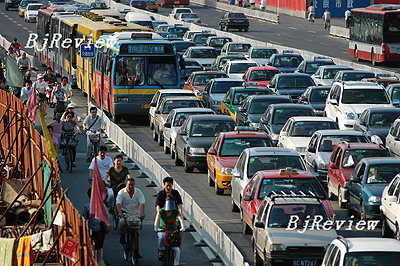
Motorization has accompanied China's economic boom, turning the nation into a society on wheels. Traffic jams, high fatalities from traffic accidents, and noise and air pollution have all put large Chinese cities on edge.
In recent years, the Chinese Government has embraced the expertise of international organizations and industries to raise awareness of road safety, in line with existing government policies and the new road safety law.
China had seen some 53 million cars on its roads by June this year, with the figure growing by 11 percent a year since 1999. According to statistics from the Ministry of Health, there are six fatalities a year for every 10,000 motor vehicles.
According to statistics from the Ministry of Public Security, there were 89,455 road deaths in 2006. This equals to an economic loss of 1 billion yuan. More than half the people killed were aged 15 to 44, the most economically productive group.
Calling traffic management a "central problem" of urban administration, Beijing Mayor Wang Qishan said recently that his top priority was to "borrow overseas experiences" in mass transmit management so as to alleviate traffic congestion in time for the 2008 Olympics.
Beijing is estimated to have 2.9 million cars now, with more than 1,000 new ones hitting the streets every day. While the capital city is excited about the Olympics next August, observers warn that poor traffic conditions may be the biggest obstacle to a successful event.
In Shenzhen, the mayor has called for consumers to "stop buying cars," saying that people were buying vehicles "too quickly." The southern city now has more than 1 million cars, with 90,000 new cars registered already this year.
A report from the Guangzhou Academy of Social Sciences says traffic jams cost the southern city up to 12 billion yuan a year, about 7 percent of its gross domestic product.
To remedy the situation, the Chinese Government has channeled 2.23 trillion yuan into the construction and upgrading of transportation facilities over the past five years. Some 645 billion yuan was spent last year alone.
By 2010, Beijing will have upgraded two subway lines and built three new lines including a special subway leading to the Olympic Village. A light-rail track will be laid to the airport while intervals between subway train services will be shortened to 150 seconds.
During the UN's first Global Road Safety Week (April 23-29), a series of events were jointly sponsored by relevant Chinese ministries along with the World Health Organization (WHO). A road show themed "harmonious traffic" carried the road safety message to six cities.
In addition to the road show, a number of seminars and forums were held to address key road safety issues, including properly treating the victims of traffic accidents. In collaboration with the Ministry of Public Security, the Ministry of Health launched a "green passage" to ensure timely treatment for traffic injury victims.
Research indicates up to 70 percent of deaths from car crashes could be prevented if the occupants wore seatbelts. However, despite the availability of seatbelts in almost all passenger cars in China and laws requiring their use, their actual use is low.
China accounts for around 15 percent of the world's annual fatalities from traffic accidents. According to the WHO, road traffic injuries are the ninth leading cause of human death globally. In China, road traffic injuries are predicted to increase a further 92 percent by 2020 in the absence of urgent prevention measures. Given this, there is an urgency to promote seatbelt use in China's major urban centers.
Against this backdrop, results of a study designed to increase seatbelt use in China were announced April 23 in Beijing. The China Seatbelt Intervention is a project coordinated between the Chinese Government, the George Institute, the WHO and BP China, aimed at increasing seatbelt use among drivers and front seat passengers.
Piloted in mid-2005 in Guangzhou and later introduced to Beijing, the 24-month project utilizes a myriad of practical approaches including enhanced law-enforcement practices, extensive social marketing and health education. It is anticipated that the project will see an increase in seatbelt use of at least 20 percent.
"It takes just a few seconds to fasten a seatbelt and these few seconds could save your life," said Prof. Mark Stevenson, Director of the Injury Prevention and Trauma Care Division at the George Institute, and head of the intervention.
The results of the intervention have shown the potential for significantly increasing the use of seatbelts among drivers and front seat passengers in motor vehicles. "Our study shows that, since implementation of the intervention, 62 percent of drivers and 53 percent passengers in Guangzhou, up from previous 50 percent and 40 percent respectively, are wearing a seatbelt," said Stevenson. "This translates into the equivalent of 530 Disability Adjusted Life Years (DALYs) saved as a result of the intervention." | 